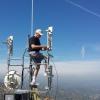I heard that the Ubiquiti equipment could be persuaded to move down into the Part 97 portion of the 2.4 GHz band, and that that ability might eventually show up in the AREDN firmware.
Is that correct? If so, a rough time frame would be really helpful for network planning (I.e., if it's 6 months we do one plan; if it's 24+ months, that's a whole 'nother plan).
Thanks in advance for any guidance.
73 - Orv - W6BI


Hi Orv,
First, for a 20 MHz link, channel 6 and below are all in the Part 97 part of the 2.4 GHz band if you use your call sign as a node identification. There are channels identified below the typically ISM band, such as 0, -1, -2, -3 supported by the Atheros chipset and within the Amateur Band... of which 0 and -1 are also within the Amateur broadband frequency coordination.
The technique for getting the chipset to operate on these channels is pretty well understood and AREDN intends to do so. However, there is a larger concern that drives the team. Moving these devices potentially takes them out of their calibrated range, and potentially out of their operating specifications.
We are currently experimenting with the M3 to understand the calibration technique and determine the degree to which the calibration file can be extrapolated into the broader 3.4 GHz ham band. We are using this band first for a number of reasons: there are no current commercial license allocations to compete with for spectrum or commercial tower space, it ultra-quiet, and it's a band that is at potential risk of being lost to other interests. Getting this technology into the 3.4 GHz band will do a lot for AREDN as well as the larger ham community.
Understanding the impacts of frequency moves on UBNT calibration will make the 2.4 GHz channels moves straight forward. Exactly when that will happen is hard to say... but I am fairly confident it will be months rather than years. Don’t look for it in the upcoming release.
Going back to your need for these channels, it sounds obvious it's driven by channel interference/poor SNR. I might suggest an alternate band... 5.8 or 3.4 GHz, while a bit more expensive to utilize, you'll find them far superior to 2.4 GHz.
Andre, K6AH
Quick question, what are the centre frequencies of the 0, -1 and -2 channels?
In the UK there are some reatrictions on the unattended use of 13cm devices in some geographical areas so could be useful to know.
Thanks
Jon
OK, I think I have answered my own question
0= 2.407
-1= 2.402
-2= 2.397
If this is the case then the restrictions in the UK between 3.92 and 2.450 would apply. Fortunately its only 2 areas in england.
Good info, Andre, thanks. We absolutely ARE using 5.8 and 900 MHz locally. If the 3 GHZ stuff weren't so much more expensive than equipment for the other bands we'd be planning on implementing it also.
73 - Orv - W6BI
Orv, it looks like the M3 is the same price point as an M9. Plus, antennas for the M3 look to be cheaper. So compared to a 2.4GHz set of equipment, you're right...the price is higher. But compared to the M9 gear you're using, it should be the same or better.
Please look at the screenshots below. We have 3 nodes that were typically seeing a SNR of 19dB when things were going well and that was yielding LQ values between 30 - 65%. We upgraded wa2kwr-22, KK9DS-04-Nano2, and N6RUF-10 to Channel -2 (2.397 GHz) with a bandwidth of 10 MHz. We now see consistent LQ and NLQ values of 100%, 100%. This is all made possible with the new AREDN beta code firmware version 3.15.1.0b01.
From Wikipedia, "In the United States, the 13 cm band comprises frequencies in two segments stretching from 2.300 to 2.310 GHz, and from 2.390 to 2.450 GHz.[2] (The segment from 2.310 to 2.390 GHz was withdrawn from the amateur service and reallocated to direct satellite radio broadcasting, e.g., Sirius XM Radio.) The segment, 2.390 to 2.417 GHz, is domestically allocated amateur radio on a primary basis, while the remainder of the band is only available on a secondary basis.[1] It is authorized to all amateur radio licensees who hold a Technician or higher class license (US), or a Basic or higher license (Canada)."
Channel -2 (2.397 GHz) with a bandwidth of 10 MHz will put the lowest part of your signal at 2.392 GHz so that you remain in band for Part 97.
Remember, if you are still supporting Linksys stations, simply add a WRT54G with a D2D link to your Ubiquiti or now your TP-Link hardware.
This new code has produced OUTSTANDING results for our corner of the mesh and I award an A+ to our development team for their efforts!!!
73,
Frank
WA2KWR
Also, if you use ch -2, AND 5Mhz bandwidth, you will be totally clear of any Part15 channel.